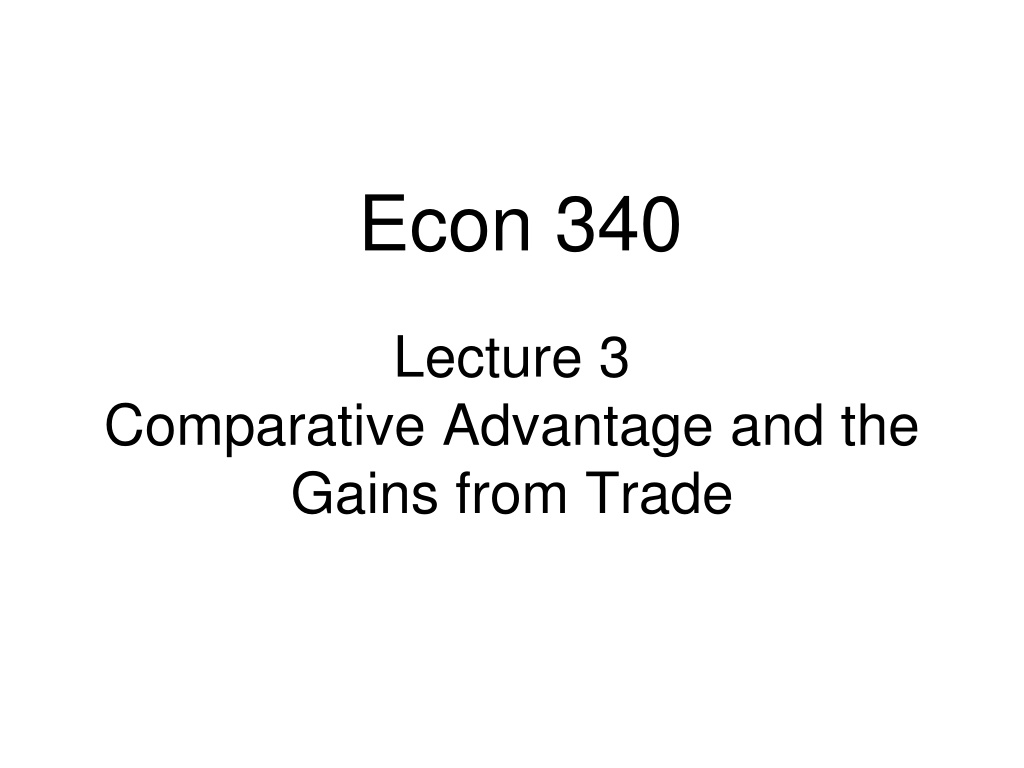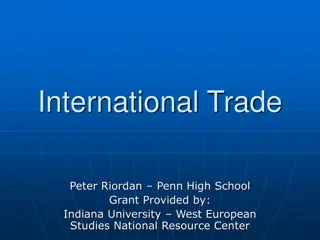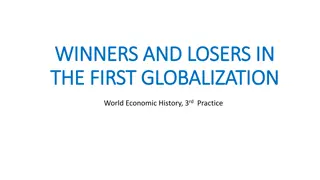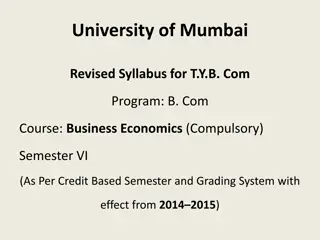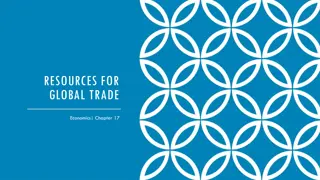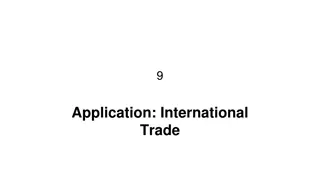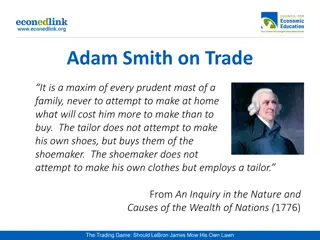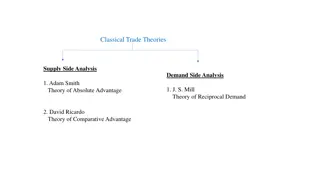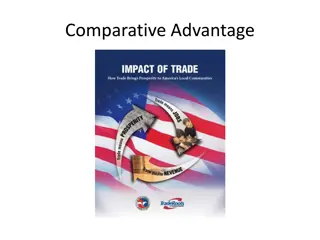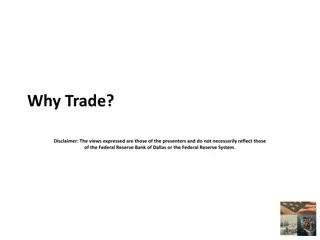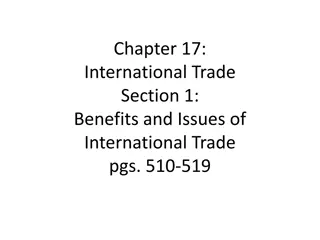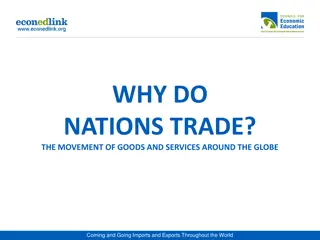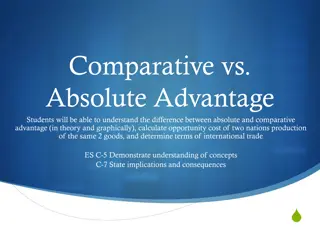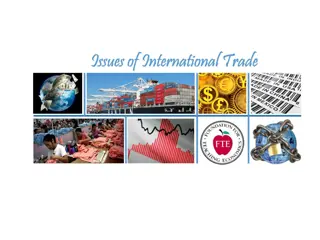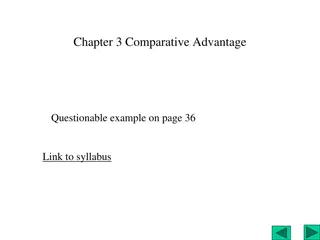Understanding Comparative Advantage and Gains from Trade
In this lecture on comparative advantage and gains from trade, the concept of why countries trade, price differences, supply and demand, the Ricardian model of trade, identifying comparative advantage, and critiques of comparative advantage are discussed. The benefits of free trade and how it leads to gains for both trading countries are explored through examples and illustrations. The lecture also covers the impact of trade on consumer surplus and the measurement of gains and losses from trade.
Download Presentation

Please find below an Image/Link to download the presentation.
The content on the website is provided AS IS for your information and personal use only. It may not be sold, licensed, or shared on other websites without obtaining consent from the author. Download presentation by click this link. If you encounter any issues during the download, it is possible that the publisher has removed the file from their server.
E N D
Presentation Transcript
Econ 340 Lecture 3 Comparative Advantage and the Gains from Trade
Outline: Comparative Advantage and the Gains from Trade Why Countries Trade Price Differences Supply and Demand Determinants of Prices Ricardian Model of Trade Examples Wages and Prices in the Ricardian Model Lessons from the Ricardian Model Generality of the Gains from Trade Identifying Comparative Advantage Critiques of Comparative Advantage Lecture 3: Comp. Advantage 2
Why Countries Trade Price differences If prices differ by more than transport costs Buyers in high-price country will import Sellers in low-price country will export Anybody in any country can profit by doing both: Buying in low-price country and Selling in high-price country Lecture 3: Comp. Advantage 3
Why Countries Trade Thus, in all cases: may lead to : trade P P A B A B that is, exports A imports B Lecture 3: Comp. Advantage 4
Why Countries Trade: Supply and Demand Autarky = No trade Country A Country B P P SB Autarky price in country B SA PB PB PA DB DA Q Q Autarky price in country A Lecture 3: Comp. Advantage 5
Why Countries Trade: Supply and Demand Free Trade = No barriers to trade Country A Country B P P SB SA PB Exp PF Imp PA DB DA Q Q PF is defined by these two distances being equal. Lecture 3: Comp. Advantage 6
Why Countries Trade: Supply and Demand Country A Country B P P SB SA PB Exp PF PA Imp DB DA = Q Q Note that price need not be half way between. Lecture 3: Comp. Advantage 7
Use areas to measure gains and losses. Country A Country B P P SB SA PB Exp c d PF b a Imp PA DB DA Q Q Lecture 3: Comp. Advantage 8
Loss of Consumer Surplus Country A Country B P P SB SA PB PF Exp b c Gains and losses from trade: d a Imp PA DB DA A s demanders lose -a Q Q Lecture 3: Comp. Advantage 9
Gain of Producer Surplus Country A Country B P P SB SA PB PF Exp b c Gains and losses from trade: d a Imp PA DB DA A s demanders lose A s suppliers gain -a Q Q +(a+b) Lecture 3: Comp. Advantage 10
Country A Country B P P SB SA PB PF Exp b c Gains and losses from trade: d a Imp PA DB DA A s demanders lose A s suppliers gain Country A gains -a Q Q +(a+b) +b Lecture 3: Comp. Advantage 11
Gain of Consumer Surplus Country A Country B P P SB SA PB PF Exp b c Gains and losses from trade: d a Imp PA DB DA A s demanders lose A s suppliers gain Country A gains B s demanders gain +(c+d) -a Q Q +(a+b) +b Lecture 3: Comp. Advantage 12
Loss of Producer Surplus Country A Country B P P SB SA PB PF Exp b c Gains and losses from trade: d a Imp PA DB DA A s demanders lose A s suppliers gain Country A gains B s demanders gain +(c+d) B s suppliers lose -a Q Q +(a+b) +b -c Lecture 3: Comp. Advantage 13
Country A Country B P P SB SA PB PF Exp b c Gains and losses from trade: d a Imp PA DB DA A s demanders lose A s suppliers gain Country A gains B s demanders gain +(c+d) B s suppliers lose Country B gains -a Q Q +(a+b) +b -c +d Lecture 3: Comp. Advantage 14
Country A Country B P P SB SA PB PF Exp b c Gains and losses from trade: d Imp PA DB DA A s demanders lose A s suppliers gain Country A gains B s demanders gain +(c+d) B s suppliers lose Country B gains World gains -a Q Q +(a+b) +b -c +d +(b+d) Lecture 3: Comp. Advantage 15
What Determines Prices, and Thus Trade? Prices determined by Productivity of labor (and other factors) Price of labor (w=wage) Exchange rate (E) (i.e., prices of currencies) Since w and E are largely common to all sectors The main determinant of how individual sectors trade (i.e., whether they export or import) is Productivity in sectors High (relative) productivity, i.e., output per worker Implies low (relative) price And hence export Lecture 3: Comp. Advantage 16
Adjustment Mechanism What if all of a country s prices are too high for it to export at all? Then either: Exchange rate (value of currency) will fall Because otherwise nobody would buy its currency, Or: Wages will fall Because nobody would hire its labor Either of these will lower the country s prices Lecture 3: Comp. Advantage 17
Outline: Comparative Advantage and the Gains from Trade Why Countries Trade Price Differences Supply and Demand Determinants of Prices Ricardian Model of Trade Examples Wages and Prices in the Ricardian Model Lessons from the Ricardian Model Generality of the Gains from Trade Identifying Comparative Advantage Critiques of Comparative Advantage Lecture 3: Comp. Advantage 18
Ricardian Model of Trade Due to David Ricardo (1772-1823) Assumptions: Production uses only labor Technology: Constant unit labor requirements (labor per unit of output) Or equivalently, constant labor productivities (output per unit of labor) ( constant here means does not vary with output ) Lecture 3: Comp. Advantage 19
Ricardian Model of Trade Example 1 (Absolute Advantage): 2 goods 2 countries Food A=US Cloth B=UK Data: Labor requirements per unit Food (hr/lb) Cloth (hr/yd) Labor endowment (workers) US .01 .02 10 UK .02 .01 10 Lecture 3: Comp. Advantage 20
Ricardian Model of Trade Autarky Equilibrium (Example only) US .01 .02 10 4 6 400 300 UK .02 .01 10 6 4 300 400 Food @ Cloth @ Labor Food Cloth Food Cloth Labor allocations Production = Consumption Lecture 3: Comp. Advantage 21
Ricardian Model of Trade US UK Trade If countries had the same currency and same wage = $10/hr, then = Food .01 .02 Cloth .02 .01 = US Food P UK Food P . 0 $ 10 . 0 $ 20 = = US Cloth P UK CLoth P . 0 $ 20 . 0 $ 10 Thus US produces Food UK produces Cloth Suppose that they both completely specialize (i.e., US produces only food and UK only cloth) Lecture 3: Comp. Advantage 22
Ricardian Model of Trade US .01 .02 10 1000 0 500 500 UK .02 .01 10 0 1000 500 500 Trade Equilibrium Food @ Cloth @ Labor Food Cloth Food Cloth Production Possible Consumption Lecture 3: Comp. Advantage 23
Ricardian Model of Trade Compare consumption in autarky and trade: Consumption in Autarky Food Cloth 400 300 300 400 Lecture 3: Comp. Advantage 24
Ricardian Model of Trade Compare consumption in autarky and trade: Consumption in Autarky Food Cloth 400 300 300 400 Consumption with Free Trade Food Cloth 500 500 500 500 Trade permits consumption to be higher, of both goods, in both countries! Both countries gain from trade Lecture 3: Comp. Advantage 25
Ricardian Model of Trade US .01 .02 UK .02 .01 Food Cloth This example had absolute advantage; that is US used less labor to produce food than UK UK used less labor to produce cloth than US But results don t depend on that Change the example UK UK (United Klutzes) Assume UK needs ten times as much labor to do anything And also has ten times as much labor Lecture 3: Comp. Advantage 26
Ricardian Model of Trade Example 2 (Comparative Advantage): Data: Labor requirements Food (hr/lb) Cloth (hr/yd) Labor endowment (workers) US .01 .02 10 UK .20 .10 100 Now US has absolute advantage in both goods, i.e., it needs (a lot) less labor Lecture 3: Comp. Advantage 27
Ricardian Model of Trade Does this matter for production, consumption, or trade? NO! In autarky, UK could produce 300 food and 400 cloth, by allocating 6 workers to food and 4 to cloth. So can UK : by allocating 60 workers to food and 40 to cloth. Lecture 3: Comp. Advantage 28
Ricardian Model of Trade With trade, UK could produce 1000 cloth by allocating all 10 workers to cloth. So can UK , by allocating all 100 workers to cloth. With trade, UK could consume 500 food and 500 cloth, by exporting 500 cloth. So can UK , by trading as before! Lecture 3: Comp. Advantage 29
Ricardian Model of Trade How does this happen? Through prices and wages Suppose initial wage is $10 in both US and UK . Then prices are: Prices Food Cloth US $.10 $.20 UK $2.00 $1.00 DISEQUILIBRIUM! Nobody would buy from UK No labor demand in UK Wage in UK must fall How far? At least to $2.00 (so PC = $.20) At most to $0.50 (so PF = $.10) Lecture 3: Comp. Advantage 30
Ricardian Model of Trade One possible trade equilibrium for US and UK US UK $1.50 $0.30 $0.15 Wage of Labor $10.00 Costs Food Cloth $0.10 $0.20 This works! Free trade prices Gains from trade Food 100 Cloth Wage in units of US UK Aut. Trade Aut. Trade 100 50 67 5 15 10 10 Lecture 3: Comp. Advantage What the wage can buy 31
Ricardian Model of Trade Implications for Fears of Trade Low productivity country (UK ) can still compete, because of its low wage High wage country (US) can still compete because of its high productivity Lecture 3: Comp. Advantage 32
Outline: Comparative Advantage and the Gains from Trade Why Countries Trade Price Differences Supply and Demand Determinants of Prices Ricardian Model of Trade Examples Wages and Prices in the Ricardian Model Lessons from the Ricardian Model Generality of the Gains from Trade Identifying Comparative Advantage Critiques of Comparative Advantage Lecture 3: Comp. Advantage 33
Gain from Trade in General This is a very simple model But it does generalize to less restrictive assumptions (trust me!) Many goods (not just 2) Many countries (not just 2) Many other assumptions can also be relaxed Lecture 3: Comp. Advantage 34
Gain from Trade in General Sources of gain from trade Most sources of gain are analogous to how individuals gain from trade Comparative advantage focuses on Differences in ability to produce goods Other sources of gain, not in this model Differences in tastes Economies of scale Lecture 3: Comp. Advantage 35
Gain from Trade in General What trade does not do: Trade does not help everybody There are losers from trade See Giles We ll see later in the course who they are Trade does not reduce inequality At least not necessarily; it could, in some cases But there are also good reasons why it may increase inequality Lecture 3: Comp. Advantage 36
Gain from Trade in General What trade does not do: Trade may not cause countries to grow faster (There is debate on that. See Giles.) Trade certainly does not fix all problems Weak or corrupt government Failure to save Poor technology (Look at UK . It gains from trade, but it is still very poor.) Lecture 3: Comp. Advantage 37
Gain from Trade in General Implications for Trade Policies Autarky is not realistic, but protection (i.e., tariffs, quotas, etc.) is very realistic Result that there is gain from trade does extend to reducing protection There are exceptions we ll see later But in most cases, countries (as a whole) do gain from reducing their tariffs Even if other countries do not reduce tariffs Countries also gain when other countries liberalize Lecture 3: Comp. Advantage 38
Outline: Comparative Advantage and the Gains from Trade Why Countries Trade Price Differences Supply and Demand Determinants of Prices Ricardian Model of Trade Examples Wages and Prices in the Ricardian Model Lessons from the Ricardian Model Generality of the Gains from Trade Identifying Comparative Advantage Critiques of Comparative Advantage Lecture 3: Comp. Advantage 39
Identifying Comparative Advantage Definition: A country has a comparative advantage in a good, relative to another good and another country, if its relative cost of producing the good is lower than the other country s (This comparison should be done in autarky, i.e., when they do not trade, because costs may change as a result of trade) Lecture 3: Comp. Advantage 40
Identifying Comparative Advantage If Cgc is the cost of producing 1 unit of good gin country c, then country 1 has a C-A in good 1 (compared to good 2 and country 2) if C C 11 12 C C Country 1 s C-A 21 22 Country 2 s C-A Lecture 3: Comp. Advantage 41
Identifying Comparative Advantage Examples Given data on unit labor requirements, since cost is proportional to these, look for where these are relatively low: Here, Peru has C-A in ham because 6 14 And Iran has C-A in eggs because Labor per unit output Country Iran 6 9 7 1 2 i.e., Peru 7 14 9 2 3 Good Ham 9 14 Eggs 6 7 Lecture 3: Comp. Advantage 42
Identifying Comparative Advantage Labor per unit output Country Iran 6 9 Peru 7 14 Good Ham Eggs In this example, you could also compare across countries: Although Peru s labor requirement is higher than Iran s in both goods, it is only 1/6 higher in Ham and it is 5/9 (>1/6) higher in Eggs 7 6<14 Lecture 3: Comp. Advantage 43 9
Identifying Comparative Advantage Examples in a different form: Given data on labor productivities (outputs per worker), since cost is inversely proportional to these, look for where these are relatively high: Here, Blog has Abs Adv in both goods. Output per unit labor Country Blog 400 8 Slog 200 5 But Blog has C-A in rugs because 400 Good Rugs 200 Drugs 8 5 Lecture 3: Comp. Advantage 44
Is the Theory of Comparative Advantage Correct? It s not easy to test, for reasons explained in Dizikes article Model says countries don t produce at all where they have no comparative advantage; so how can you measure productivity there? Economists Costinot and Donaldson get around this with data on land characteristics They find support for the theory Lecture 3: Comp. Advantage 45
Is the Theory of Comparative Advantage Correct? Problem: Comparative Advantage is defined in terms of autarky prices These normally cannot be observed Bernhofen & Brown do observe them from historical Japan, which was closed to trade prior to 1859 They found: Japan exported products with relatively low prices during autarky and imported products that had relatively high autarky prices. Gains were 7% of GDP Lecture 3: Comp. Advantage 46
How Large Are the Gains from Trade? Costinot and Rodriguez-Clare use a model to estimate the gains from trade Their estimate for the US today ranges from 2% to 8% of GDP Why the large range? It depends crucially on the elasticity of demand for imports This determines how easily consumers are able to substitute domestic goods for imports If low, then we need imports more than if high Lecture 3: Comp. Advantage 47
Outline: Comparative Advantage and the Gains from Trade Why Countries Trade Price Differences Supply and Demand Determinants of Prices Ricardian Model of Trade Examples Wages and Prices in the Ricardian Model Lessons from the Ricardian Model Generality of the Gains from Trade Identifying Comparative Advantage Critiques of Comparative Advantage Lecture 3: Comp. Advantage 48
Critiques of Comparative Advantage Some argue that Ricardian assumptions no longer hold Some say the Ricardian Model assumes Factors are freely mobile within countries Factors are immobile between countries Without these assumptions, they say, countries lose from trade NOT TRUE! Relaxing either assumption does not interfere with the gains from trade Lecture 3: Comp. Advantage 49
Critiques of Comparative Advantage - Prestowitz Prestowitz cites a study by 3 very respected (by me) economists They measures losses from increased trade with China Find them to be significant Prestowitz concludes that US may have lost from this trade Yes, there are both losses and gains Large losses, yes, but even larger gains Lecture 3: Comp. Advantage 50
